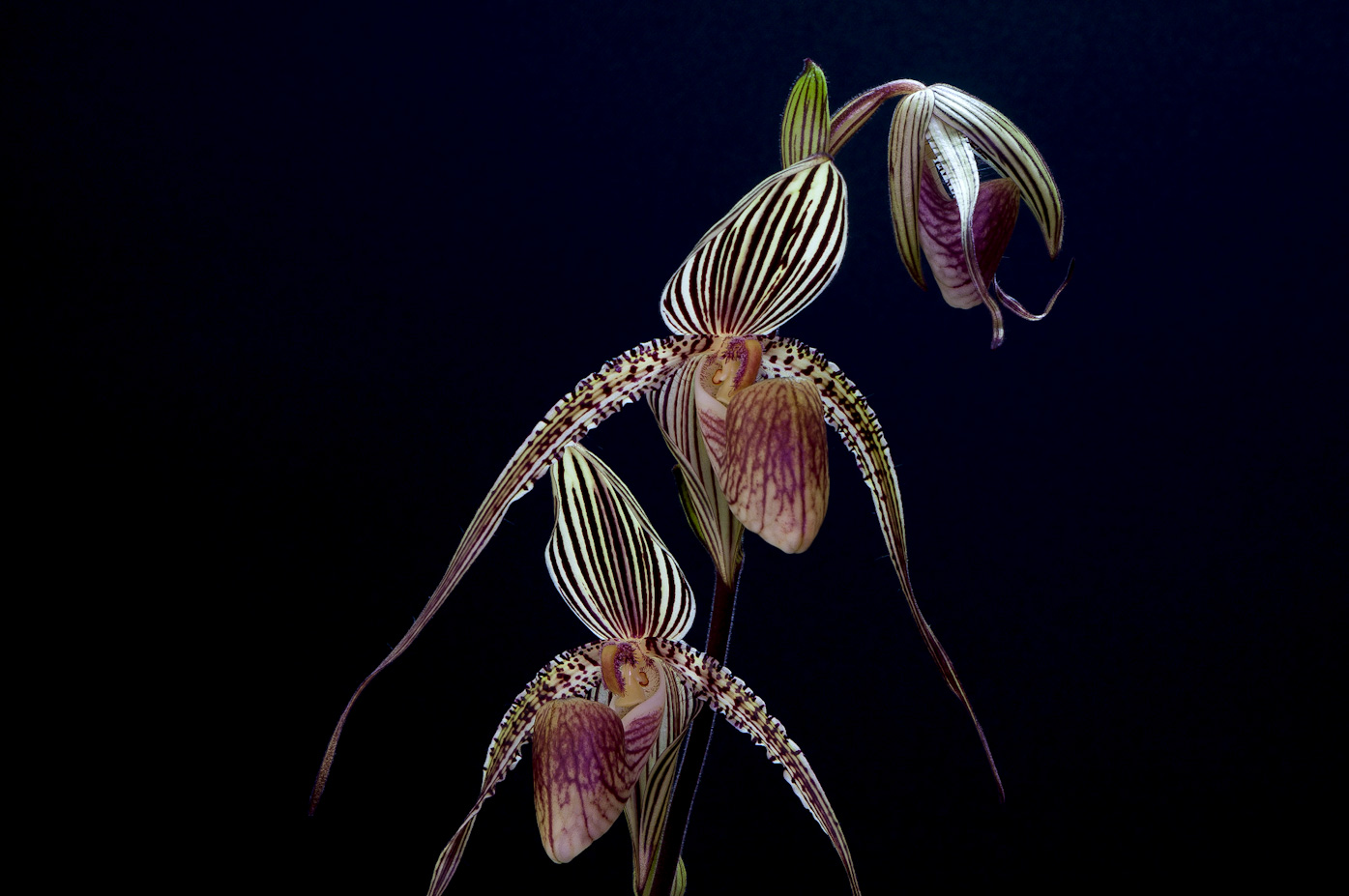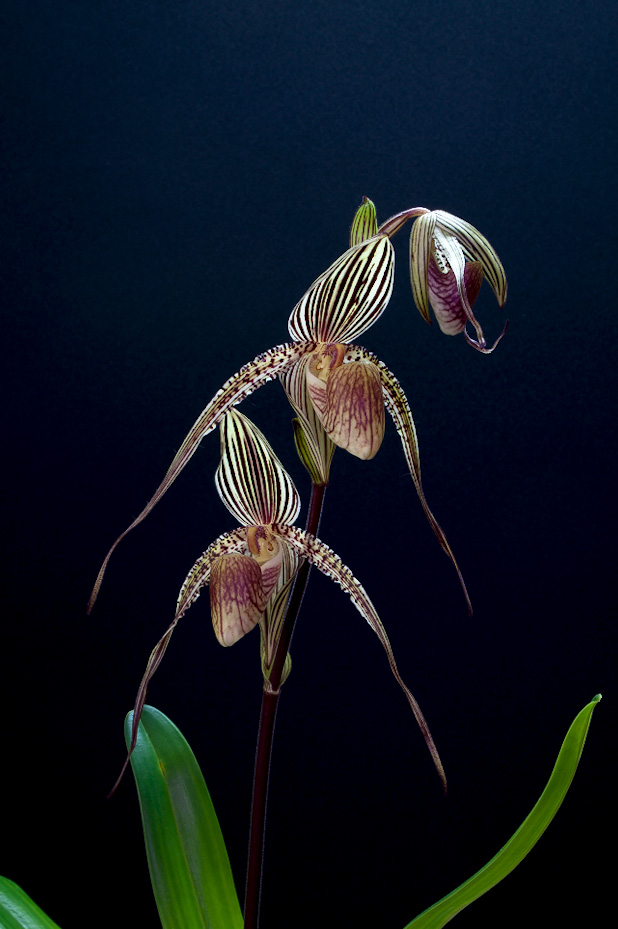You are using an out of date browser. It may not display this or other websites correctly.
You should upgrade or use an alternative browser.
You should upgrade or use an alternative browser.
Paphiopedilum ( Deena Nicole x Booth's Sand Lady ) x sanderianum
- Thread starter vandacee
- Start date

Help Support Slippertalk Orchid Forum:
This site may earn a commission from merchant affiliate
links, including eBay, Amazon, and others.
SlipperKing
Madd Virologist
Nice one!
1
17andgrowing
Guest
Lovely.
Kind of surprised the petals aren't longer, but I like the clean stripes and spots.
Mike
Mike
NYEric
Well-Known Member
Interesting.
Justin
Well-Known Member
i like the color contrast
Migrant13
Mature growth?
Looks nice.
SlipperFan
Addicted
And beautifully photographed.
where has the sanderianum gone?
Great photo!
Great photo!
Very nice flowers! I am surprised, too, that the one dose of roth is still quite obvious from 3 generations ago, while the two later portions of sanderianum are not very evident.
Deena Nicole = philippinense x glanduliferum var. praestans
Booth's Sand Lady = Lady Isabel x sanderianum
It is fragrant like a rothschildianum !
D
Drorchid
Guest
Deena Nicole = philippinense x glanduliferum var. praestans
Booth's Sand Lady = Lady Isabel x sanderianum
It is fragrant like a rothschildianum !
Which means this hybrid is:
62.5% sanderianum
12.5% philippinense
12.5% praestans
6.25% stonei
6.25% rothschildianum
Yes, I would also expect to see it look more like a Paph. sanderianum, and less like a rothschildianum. This cross almost looks like it is 50% rothschildianum! Interesting result!
Robert
Which means this hybrid is:
62.5% sanderianum
12.5% philippinense
12.5% praestans
6.25% stonei
6.25% rothschildianum
Yes, I would also expect to see it look more like a Paph. sanderianum, and less like a rothschildianum. This cross almost looks like it is 50% rothschildianum! Interesting result!
Robert
I thought that for more sandy to show itself, sandy needs to be one of the parents, not just a majority from the background. So even though Booth's Sands lady would contribute more than 50% sanderianum, its not enough for the long petalled traits to come through. Back crossing so there is 50% sandy not really helpful in preserving the long-petal trait (e.g. Angel Hair x PEOY = 50% sandy, but looks more like long petalled St. Swithin).
Or maybe the Booth's Sands lady used a PEOY as a parent, and not a true sanderianum?
D
Drorchid
Guest
I thought that for more sandy to show itself, sandy needs to be one of the parents, not just a majority from the background. So even though Booth's Sands lady would contribute more than 50% sanderianum, its not enough for the long petalled traits to come through. Back crossing so there is 50% sandy not really helpful in preserving the long-petal trait (e.g. Angel Hair x PEOY = 50% sandy, but looks more like long petalled St. Swithin).
Or maybe the Booth's Sands lady used a PEOY as a parent, and not a true sanderianum?
This cross was Paph. (Deena Nicole x Booth's Sand Lady ) x (sanderianum)
so Paph. sanderianum was one of the parents, and it is in the background of the other parent! I have seen crosses with only 50% sanderianum (as it was also one of the parents), like Paph. Kolosand, Paph. Fumimasa Sugiyama, Paph. Michael Koopowitz, Paph. Prince Edward of York, Paph. Sander's Pride etc..that look more like "sanderianum" than this cross..
I just find it interesting that in this cross, Paph. rothschildianum seems to be so dominant (even though it is only 6.25% of the cross).
Robert
Wendy
Just me!
It is pretty but I don't see much sanderianum in there. Hmmmmm
K
khrisna.9
Guest
Wow i love it
emydura
Well-Known Member
This cross was Paph. (Deena Nicole x Booth's Sand dy ) x (sanderianum)
I just find it interesting that in this cross, Paph. rothschildianum seems to be so dominant (even though it is only 6.25% of the cross).
Robert
Just chance. If you flowered a whole heap of these, most would not look like this. I think this is an outlier. Having said that, with five species involved in the mix, you will see some incredible variation.
F
Felix
Guest
A nice hybrid, but there should be more Paph. sanderianum - influence. Though there is variation of course, there must be at least 50% sanderianum. I don't really see it.
Camellkc
Well-Known Member
Surprised that the trait of roths is still dominant.
emydura
Well-Known Member
A nice hybrid, but there should be more Paph. sanderianum - influence. Though there is variation of course, there must be at least 50% sanderianum. I don't really see it.
Genetically that may be correct, but in terms of the phenotype that is displayed, that statement is incorrect.
Similar threads
- Replies
- 5
- Views
- 430
- Replies
- 9
- Views
- 827




